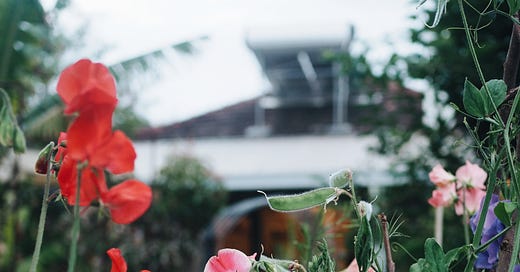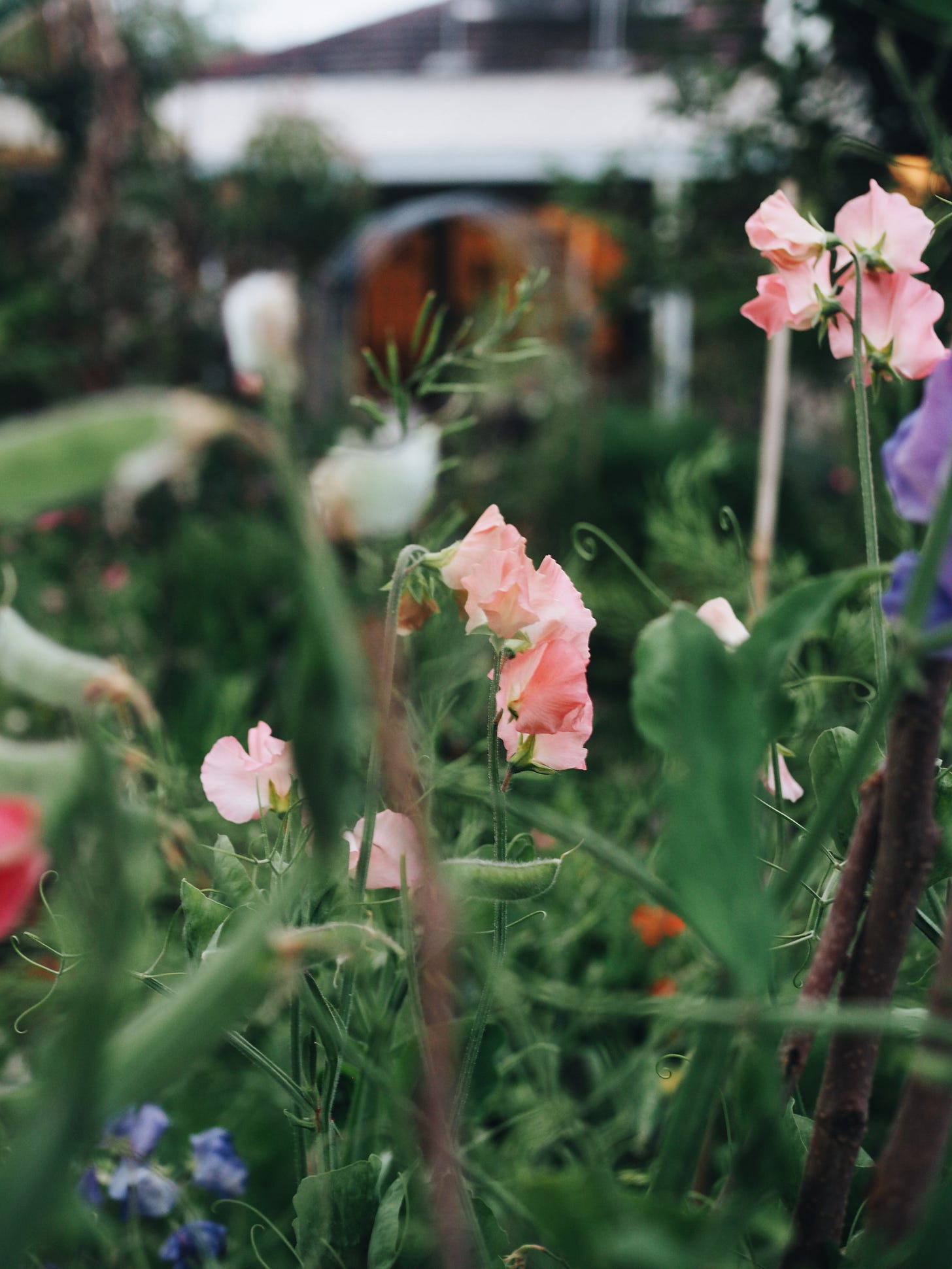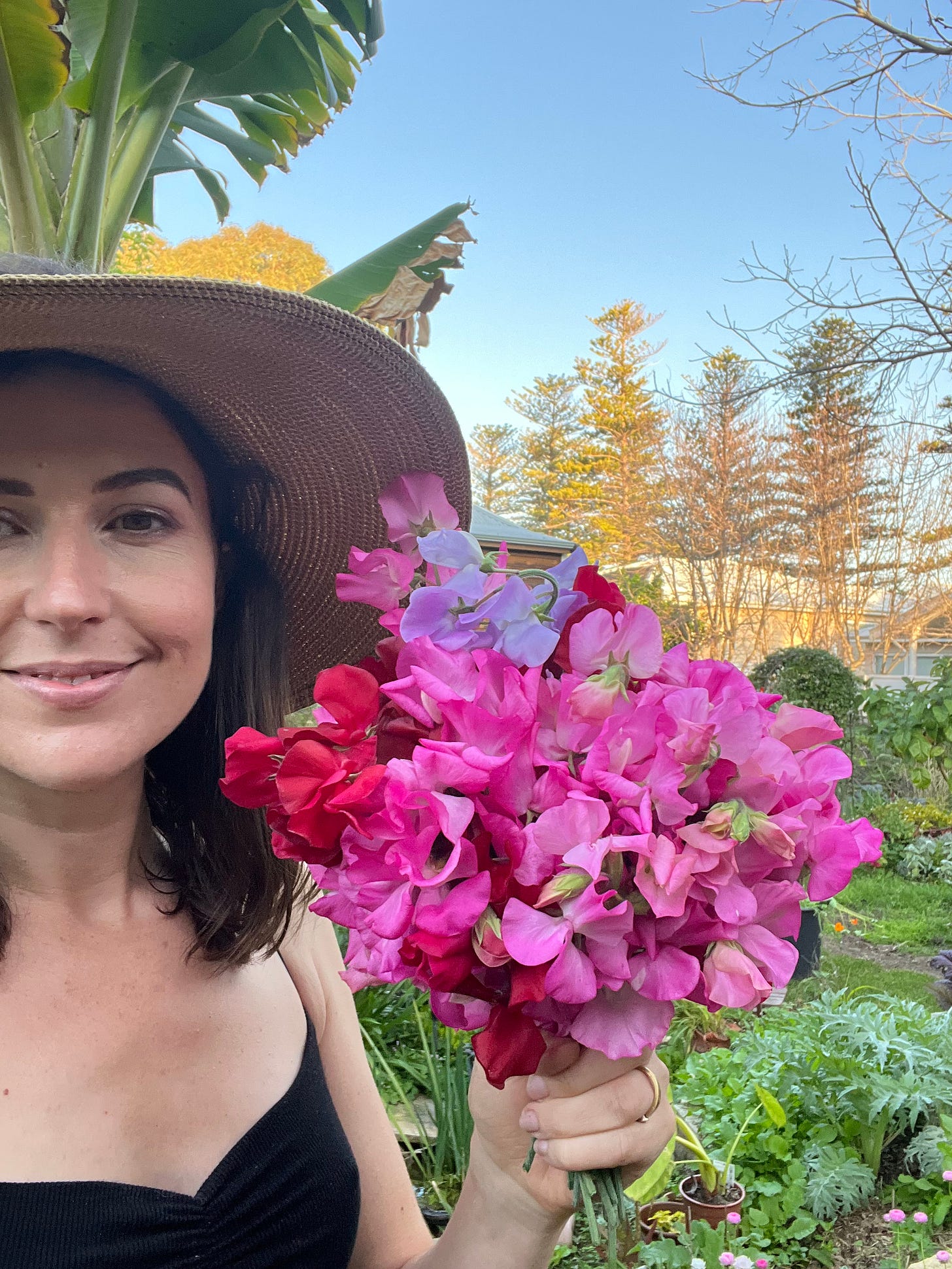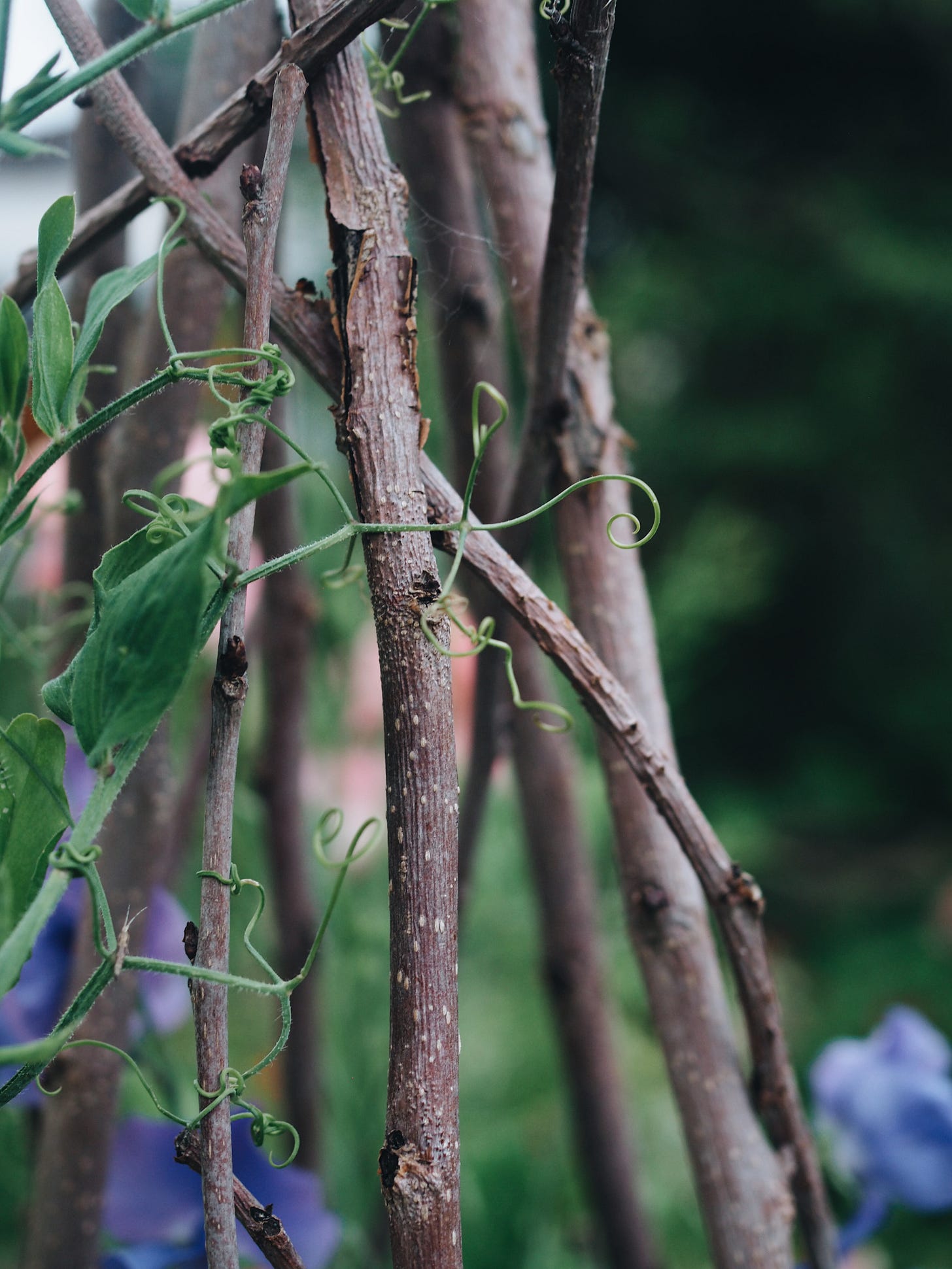How to grow perfect sweet peas
Your comprehensive guide to WINNING AT SPRING (and life in general)
Welcome to Lo fi life, a cheerfully unsophisticated newsletter about gardening, cooking and things that are good. Not subscribed yet? Click the button:
If you’re not growing sweet peas yet, you should be.
I’m not sure how a little climbing flower from Sicily evolved to smell like a cotton candy dream, but somehow the humble sweet pea has managed it. If a seagull pecked out both your eyes and flew off with them, my advice would be to grow sweet peas and just spend the rest of your life wandering around your garden happily snorting their heavenly scent.
These glorious flowers bloom in almost every colour - mottled pastels, striped reds and purples, salmon pink, pure white with ruffles - set atop long thin stems that make them perfect for picking. Sweet peas epitomise spring, ushering in seasons of cloudless skies and warm weather. They’re relatively easy to grow (provided you get a few basic things right) and will reward your care and diligent watering with weeks of blooms and a garden that smells like a parfumerie.
Clearly I’m a bit obsessed. But the truth is, until a few years ago I really wasn’t that good at growing them. They’d usually did okay in my garden, but only okay and I never got the tumbling onslaught of blooms I’d hoped for. Fortunately, the lovely thing about gardening is that we improve one season at a time, and every year is a new blank slate and a chance to try again. At some point in the last few years, I managed it. And now, looking back, I’m amused to say that I’m actually putting in substantially less effort than I used to.
In fact, this newsletter is a heavily revised reprint of a blog post I wrote several years ago. I had decided I wanted to finally perfect my sweet pea growing and so I did a deep dive into the internet abyss, determined to learn the secrets of a successful sweet pea. Honestly, I can’t even remember if it worked. I remember there being a lot of tips and rules. You know what I think probably happened? I probably followed all the advice and tried reaaaally hard and my sweet peas were probably, once again, only ok.
Grumble grumble.
Well I’m older and wiser now, and in the last two years my style of gardening has changed rather drastically. Being pregnant and generally buggered meant that 2022 passed in a flash with relatively little gardening to speak of, and I spent most of 2023 learning how to be a parent and definitely not diligently tip pruning sweet peas.
AND THEY WORKED EVEN BETTER THAN BEFORE.
I think this is how it always is in the garden. There are always a few solid, basic things you really should get right, and then the rest of the advice is total clutter. Probably just there so that the person writing the book/blog/newsletter can meet some arbitrary word count (they don’t seem to realise that if you want to write long-form content you can just blather about motherhood, seagulls and eye injuries).
I’m happy to say that my recent sweet pea success boils down to just a few key things, and that you CAN - and definitely should - grow sweet peas successfully with minimal effort, ten kids, no time and two bleeding sockets where your eyes used to be (just get one of your ten kids to help you sow them in a straight line).
Here’s what matters and what you should do.
Buy ‘highly scented’ varieties
First thing’s first, there is just no point in growing sweet peas if they aren’t scented.
Originally all sweet peas were highly perfumed but now some of the modern varieties are not particularly scented at all. I don’t know who bred these scentless varieties but they are a soulless monster. In my opinion, growing a sweet pea that has no perfume is about as criminal as baking a cake that has no sugar. All show and no substance. I refuse to buy a sweet pea that isn’t scented and I am brutally offended when I bend to sniff one on my travels and come back nasally bereft.
To ensure you don’t suffer the same olfactory disappointment in your own garden, I strongly recommend checking on each packet before you buy your sweet peas. The scented varieties will almost always say ‘highly fragrant’ or ‘perfumed variety’ if the sweet peas carry that beautiful scent from yesteryear.
Ignore the old saying that ‘you must sow sweet pea seeds before Anzac day’
This advice is nonsense. I get that it’s useful if you need a reminder to sow your sweet peas, but I suspect the unintended consequence is that it leaves a lot of people thinking they’ve missed their chance if they haven’t sown seeds before this (entirely arbitrary) cut off, and so they just don’t bother.
The truth is that sweet peas have a nice long growing season (especially for those of us growing them in mild climates like Perth where there are no winter frosts). If you live in a mild climate in the Southern Hemisphere, you can sow sweet pea seeds anytime in March, April or May.
In fact, if you miss the autumn sowing window, you can even plant sweet pea seeds in spring. Just note that sweet peas planted in spring may not grow quite as large or flower quite as prolifically, and will likely bloom a little later than seeds planted in autumn.
The bonus good news is that because the window for seed sowing is actually way bigger than people assume, you can also sow seeds in batches throughout autumn and spring (this is called ‘succession planting’). Each batch will come into flower at a different time, meaning you can have flowers for a much longer period than if you’d simply planted all your seeds in one go.
(You can also be totally disorganised, forget about sweet peas entirely, suddenly remember them in a blind panic mid-way through April and bung some in in May and you’ll be just fine.)
Ignore advice to ‘scarify’ or soak sweet pea seeds before sowing
Another example of people making things more complicated than they need to be.
There’s plenty of advice online saying that you should either ‘scarify’ (scratch) the hard outer shell of sweet pea seeds prior to planting, or soak the seeds overnight before you sow them. I came across this advice numerous times in my researching, but it was contradicted by a few people who I regard as more trustworthy than Joe Blogs and his gardening blog (namely, the inimitable Monty Don and Dr Keith Hammet; a sweet pea cultivating expert from New Zealand who is responsible for breeding many of the beautifully perfumed cultivars sold across the world today). They said not to bother with all that fiddly nonsense, so I don’t!
Also - soaking and scarifying the seeds can do more harm than good; soaking seeds can deprive them of necessary oxygen and cause them to rot before they germinate, while scratching the wrong part of the seed can damage it irreparably.
And it’s boring and time consuming.
Get lazy, sow your seeds direct
Back when I had the time and energy to do a lot of unnecessary faffing I sowed all my sweet peas in neat little punnets, labelled them all, nurtured them for weeks then ran out of time and energy and left them to get root bound and sad in their pots because I’d sown too many and had no idea where they should go.
I thought it was important that I start them in punnets, because I’d seen gardeners on TV do it, and I thought it was important that I labelled every punnet so I knew exactly what I was growing (despite the fact that I instantly forgot once I’d removed them from their punnets).
Now that time and energy have become more precious resources, I’ve made a few decisions I am quite pleased with.
First, I don’t care about knowing which specific cultivars of sweet pea are blooming in my garden as long as they bloom and smell nice. This decision has been a huge relief.
Next, I have decided there is next-to-no point sowing seeds in punnets. I think the gardeners on TV mostly do it because they want to start seeds in autumn and live in regions where they need to protect the seedlings from frosts. We have no frosts in Perth, so we don’t need this added layer of fussing. Sweet peas have quite deep root systems anyway and don't love being disturbed. Sowing them direct is one less job for you and one less stressor on the plants. Everybody wins!
“But what about bugs eating my seedlings!?” I hear you cry. Well, it’s true that there might be slightly better protection for your sweet peas if you sow them in punnets, but not enough to convince me to do it. Here’s what I do instead:
First, I sow my sweet peas in a spot that gets sun all day, in really good quality, enriched soil (more on that in a mo’), and with regular water. This means the plants are as healthy as possible and healthy plants are less likely to be munched.
Second, I sow a tonne of seeds. I’ve been thinking about how we treat seed sowing lately and this is probably a tangent I should save for another time but… ok, in a nutshell - a single plant produces vastly more seeds than it could ever possibly hope to grow, right? You can get hundreds of seeds from a single flowerhead. Plants have evolved to produce masses of seeds precisely because, in nature, so few of them will successfully germinate, grow, survive and reach maturity themselves. It’s a dog eat dog world out there. So, instead of treating every single seed I buy with the utmost reverence, instead of expecting to get a healthy plant out of every one I sow, I just plant a shitload of them in my garden and hope that a few good ones make it.
This process might sound wasteful, and the first year it might be a little, but if you make a point of saving your own seeds (from the healthiest plants that ‘made it’) you’ll wind up with vastly more seeds than you know what to do with, for plants that tend to be tougher and hardier, and you can fling them with reckless abandon ever season thereafter. So I plant a lot of seeds. I ignore the ‘planting distance’ advice to sow them every 20-30cm and I plop them in direct about every 5-10cm. Heaps don’t make it, but the ones that do are usually more than enough for plenty of blooms.
If you want to plant your sweet peas in pots, have at it, but I still wouldn’t bother starting them in seedling trays. Choose a nice big pot (a half wine barrel-sized pot would be ideal) and fill it with a really good quality potting mix - maybe even a little animal manure), then sow them direct in there.
Give them great soil to grow in
Sweet peas like to eat and, if you feed them well, will grow strong stems and many blooms. So it’s important to enrich the soil before planting them. Dig a few bags of sheep or cow manure into your garden beds before sowing sweet pea seeds. If you’ve got a compost tumbler, add some compost as well.
If your soil is barren, sandy and dry, have a read of my soil improvement tips in this newsletter before you get started. If you’re a paying subscriber you can also read this step by step guide and watch this video where I show you how I improve the soil in one of my dry, neglected beds.
Keep them well watered
Sweet peas don’t like to dry out so, once they’re big enough, spread a good quality mulch around the base of the flowers. I like to use lupin mulch as it adds structure and nitrogen into the soil (and encourages worms), which the plants love!
Mulching around the base of the flowers will help stop the soil drying out on hot days, but it’s important to also make sure the sweet peas get plenty of water - they are thirsty plants and under-watering results in kind of puny, leathery and dry leaves, fewer blooms and plants that will quickly stop flowering and just set seed.
Give them ‘cool feet and warm heads’
Sweet peas need to be in a sunny position to thrive, but like clematis, they really enjoy shade on their feet and their faces in the sun. This means that ideally the base of the plant will be shaded and kept cool, while the climbing tendrils will be growing up into bright, direct sun. To achieve this, you can plant small annuals (e.g., calendula, marigolds, vincas) at the base of the sweet pea plants to shade their roots while their heads stretch towards the sunlight.
In our garden, I sow sweet pea seeds at the base of our front fence every autumn. Their ‘feet’ (the base of the plants) are partly shaded by a row of citrus trees when they’re little, but as they grow and cling to the fence their ‘heads’ are increasingly in the sun. It works well!
Give them something to grow up
Speaking of our front fence, I think one of the reasons I’m now having more luck with my sweet peas is that they finally have a good structure to grow up. In years previous I grew my sweet peas up what I *thought* were good climbing frames, only to discover mid-way through spring (when it was definitely too late to do anything about it) that my climbing frames were in fact puny, weak, and made from materials (chunky bamboo or thick wire) that they couldn’t properly grip onto.
There are three mistakes I see people make with their sweet pea climbing frames:
The frames are way too small and flimsy to support a healthy plant - the plant rapidly outgrows the frame and has nowhere to go so starts to flail and droop. Sweet peas that are well fed grow tall and prolifically (up to 2m!) and little trellises from Bunnings aren’t going to cut it - you need something sturdy and tall. When it comes to the support, go big and strong or go home!
The frames aren’t properly secured to a wall/the ground and ultimately can’t support a mature plant’s weight (inevitably these frames decide to topple over just as your plants are bursting into bloom which just…sucks). Make sure they are very sturdy - more than you think!
The frames are too chunky and thick for the sweet peas to grip. As a rule of thumb, your sweet peas will need a frame made out of a material that is no more than a few mm thick in order to grab hold and twine their tendrils around it. This doesn’t mean the whole structure needs to be made from that thin gauge material, just some of it (see the mulberry stick teepees I made below - the thick sticks provided the height and strength, the thin twigs gave the peas something to cling onto). Thin gauge materials could include things twine, thin sticks or chicken wire. Make sure it’s incorporated into the structure right from the base, so the sweet peas can reach it when they’re still just little - that’s when they need this kind of support most. Once they have attached securely to the base of the frame and clambered up half a meter or so I find they need less support (but it still helps)
Finally, install your growing frames ahead of time (ideally when - or before - sowing your seeds) and don’t cobble something together at the last minute - sweet peas that are well supported right from the start will thrive, while those that sprawl around on the ground or in nearby shrubs do not.
Pinch out the growing tips…or don’t.
Honestly I really don’t think this makes a giant difference. Some gardeners swear that you should ‘pinch out’ your sweet peas, that is, that you should pinch the tip off each plant once it’s reached about 15cm in height (or when the stems have grown long enough to have four sets of leaves). Pinching out sweet peas is said to encourage them to grow more lateral side shoots instead of sending up a single vertical shoot, leading to dense and bushy plants.
In my opinion, it will not make or break your sweet pea patch - I haven’t bothered with it over the last several years and I really can’t say it’s made any huge impact. Good soil, plenty of water and sun are way more important things to get right. Maybe pinching out is the cherry on top of the cake? I wouldn’t know, my cakes are too slap dash and quickly eaten to be topped with cherries (and anyway I prefer double cream).
Pick pick pick!
Pick your flowers! I always struggle to pick flowers out of my garden because I feel like I’m committing them to death in a vase and depriving the bees of pollen. BUT (like many annual flowers) the thing about sweet peas is: the more you pick, the more they flower.
By not picking the flowers, you are telling the plant that it’s time to set seed - basically that the season is over and their job is done. This means the fewer flowers you pick (and the more you leave on the plant) the fewer flowers the plant will produce. So everyone loses. Instead, enjoy your sweet peas!! Pick big bunches about every 9-10 days and your plants will go on flowering for weeks on end - a bonus for you, your garden and the bees.
Finally, pick your (dry) seedpods! As your sweet peas reach the end of the season, their blooms will start to taper off. I also find end-of-season blooms occur on shorter, stumpier stems so they aren’t as great for picking. At this point, I’ll stop picking the flowers and will leave them on the plant to form pods. Wait until the pods are plump and brown and dry (not green or leafy), then pop them open into a bowl and save the seeds.
A word of caution: if the pods are suuuuper dry and brown they will start to pop open on their own, flinging their seeds in little explosions into your garden. Their explosiveness is a clever evolutionary adaptation - the seed pods snap open and throw the seeds as far as possible to help the plants spread. Try to pick your pods carefully so they don’t just explode if your hands. But if they do, don’t stress, it might just mean you get to enjoy some bonus self sown sweet peas in surprise locations next spring when the whole glorious, fragrant, floral dance begins again!
Thank you for reading! See you next time for more Lo fi life!
P.S. If you are enjoying my newsletter and know someone else who might like it too, hit the button below to send them a referral. Readers who refer 3 friends will receive a bonus 1 month’s subscription to Lo fi life for free!











I’m also inspired to grow them! Is there a brand/distributer of seeds that you recommend?
I finally found the perfect spot to grow a profusion of these favourite flowers, then we got a dog, and I read somewhere that sweet peas are poisonous for dogs- have you heard this? Do your dogs mingle with your sweet peas?
Thanks
Lisa